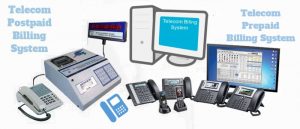Evolution of technology has touched each and every aspect of our lives. There are some changes we experience, like evolution of social platforms such as Facebook and there are some changes that we don’t, like evolution of telecom postpaid billing system.
After passing through many levels of abstraction, the telecom services are delivered to our doorsteps and we simply don’t bother about their complexity. Worried, that something could go wrong! Don’t be, the telecom billing systems of today are innovative, robust and most important of all, they are reliable. Want to know what makes them work so well, read on.

Telecom Billing System
The top telecom billing system is so vast that this article may not have enough space to cover all its features. But, we can discuss a few key features and enlighten ourselves on its various key facets. Let’s start with a comparison:
Telecom Postpaid Billing System vs. Telecom Prepaid Billing System
When a customer decides to subscribe to a telecom service provider, he has two options: Prepaid or Postpaid. Prepaid users are generally higher with almost 70% users preferring it over postpaid. However, postpaid plan has its own advantages – both for customers and providers – that will become clearer from the comparison below:
Billing – Telecom prepaid billing procedure is much more rigorous than postpaid billing. As a customer pays before using the services, his account needs to be updated in real-time. On the other hand, postpaid billing is a lot easier to handle for service providers as they can charge customer at the end of the month.
Prepaid plan eliminates the chance of overusing the data and postpaid plan ensures convenience in bill payments.
Services – Real-time charging (in prepaid billing) is not suitable for handling the requirements of business customers. As the charges need to be analyzed, bifurcated and altered depending on the business plan, it becomes harder to do so much in real time.
For business customers, postpaid billing is an ideal solution as it allows for better maintenance of customers’ records according to their hierarchy.
How Telecom Postpaid Billing System Works?
To understand the operations of postpaid system, we should know the information required by the billing system.
- The number from which the call is made
- The number to which the call is made
- Starting time of the call
- Duration of the call
- Type of call
When a call is made, the above mentioned pieces of information, which are also known as CDR attributes are received by a billing system. The system converts this information into a format, which could be understood. The converted information is guided to the customer’s account and CDRs are charged and rated according to the customer’s plan.
After rating is done, the information is stored in the billing system. Later, on the billing cycle date (the date of bill generation), the information is processed and converted into bill/invoice. During the invoicing process, relevant taxes and discounts are also applied. The bill is sent to the customer. The bill has a due date before which the customer should make the payment. If the customer fails to make the payment in specified time, then he incurs a late payment fees. The fee is added to the billed amount. After the reception of payment, the customer’s account is updated.

